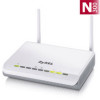ZyXEL WAP3205 User Guide - Page 86
What You Should Know, 10.3.1 Wireless Security Overview
 |
View all ZyXEL WAP3205 manuals
Add to My Manuals
Save this manual to your list of manuals |
Page 86 highlights
Chapter 10 Wireless LAN • Use the MAC Filter screen (Section 10.6 on page 93) to allow or deny wireless stations based on their MAC addresses from connecting to the WAP3205. • Use the Advanced screen (Section 10.7 on page 94) to configure wireless advanced features, such as set the RTS/CTS Threshold and HT physical mode. • Use the QoS screen (Section 10.8 on page 95) to enable Wifi MultiMedia Quality of Service (WMMQoS). This allows the WAP3205 to automatically set priority levels to services, such as email, VoIP, chat, and so on. • Use the WPS screen (Section 10.9 on page 96) to quickly set up a wireless network with strong security, without having to configure security settings manually. • Use the WPS Station screen (Section 10.10 on page 97) to add a wireless station using WPS. • Use the Scheduling screen (Section 10.11 on page 97) to set the times your wireless LAN is turned on and off. • Use the WDS screen (Section 10.12 on page 98) to configure Wireless Distribution System on your WAP3205. 10.3 What You Should Know Every wireless network must follow these basic guidelines. • Every wireless client in the same wireless network must use the same SSID. The SSID is the name of the wireless network. It stands for Service Set IDentity. • If two wireless networks overlap, they should use different channels. Like radio stations or television channels, each wireless network uses a specific channel, or frequency, to send and receive information. • Every wireless client in the same wireless network must use security compatible with the AP. Security stops unauthorized devices from using the wireless network. It can also protect the information that is sent in the wireless network. 10.3.1 Wireless Security Overview The following sections introduce different types of wireless security you can set up in the wireless network. 10.3.1.1 SSID Normally, the AP acts like a beacon and regularly broadcasts the SSID in the area. You can hide the SSID instead, in which case the AP does not broadcast the SSID. In addition, you should change the default SSID to something that is difficult to guess. This type of security is fairly weak, however, because there are ways for unauthorized devices to get the SSID. In addition, unauthorized devices can still see the information that is sent in the wireless network. 10.3.1.2 MAC Address Filter Every wireless client has a unique identification number, called a MAC address.1 A MAC address is usually written using twelve hexadecimal characters2; for example, 00A0C5000002 or 86 WAP3205 User's Guide















